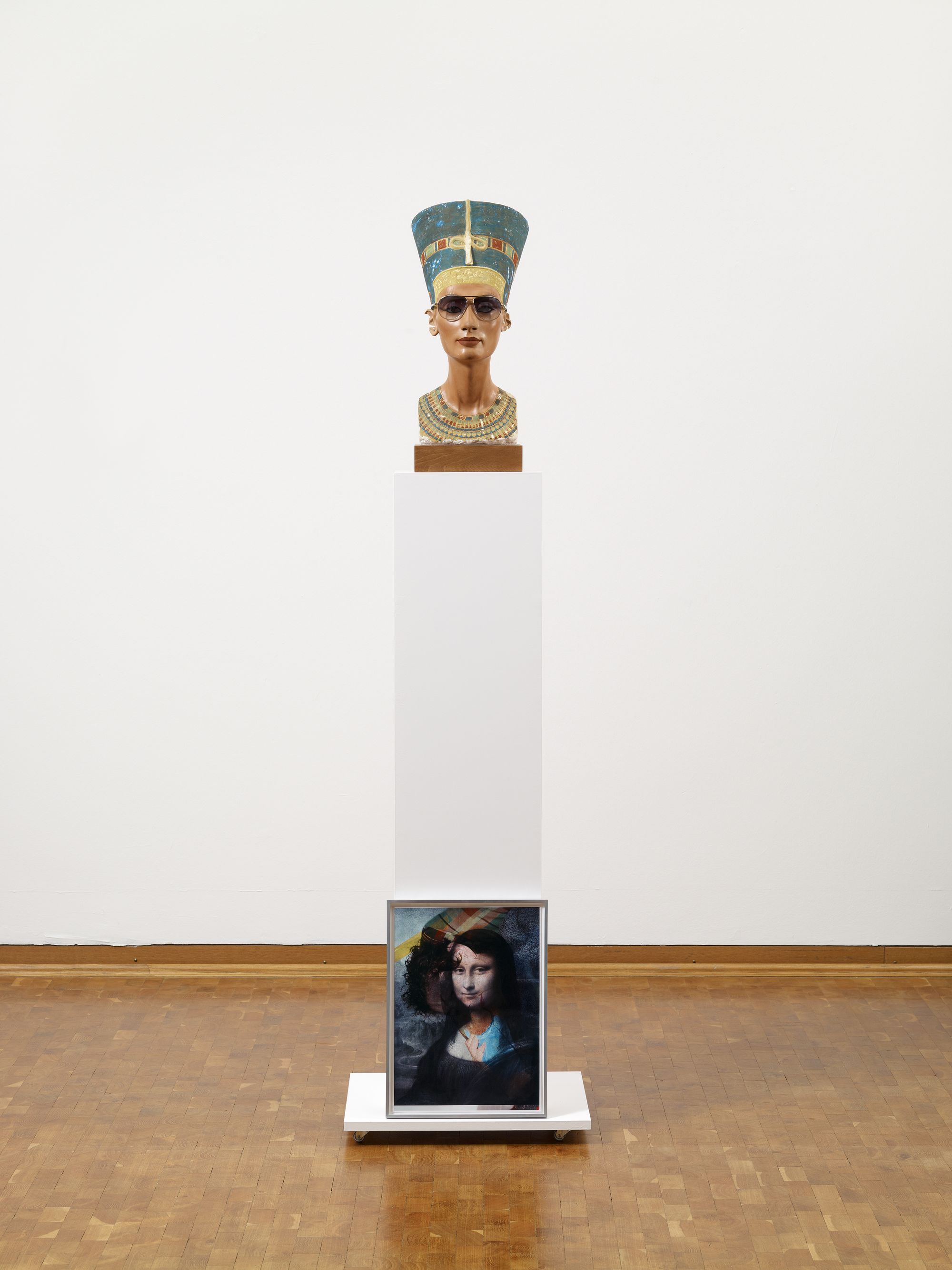
Isa Genzken, Nofretete – Das Original, 2012. Nefertiti plaster bust with sunglasses on wooden base, wooden plinth and colour photograph in aluminium frame. Courtesy Galerie Buchholz © VG Bild-Kunst, Bonn 2023. Photo: Sascha Fuis.
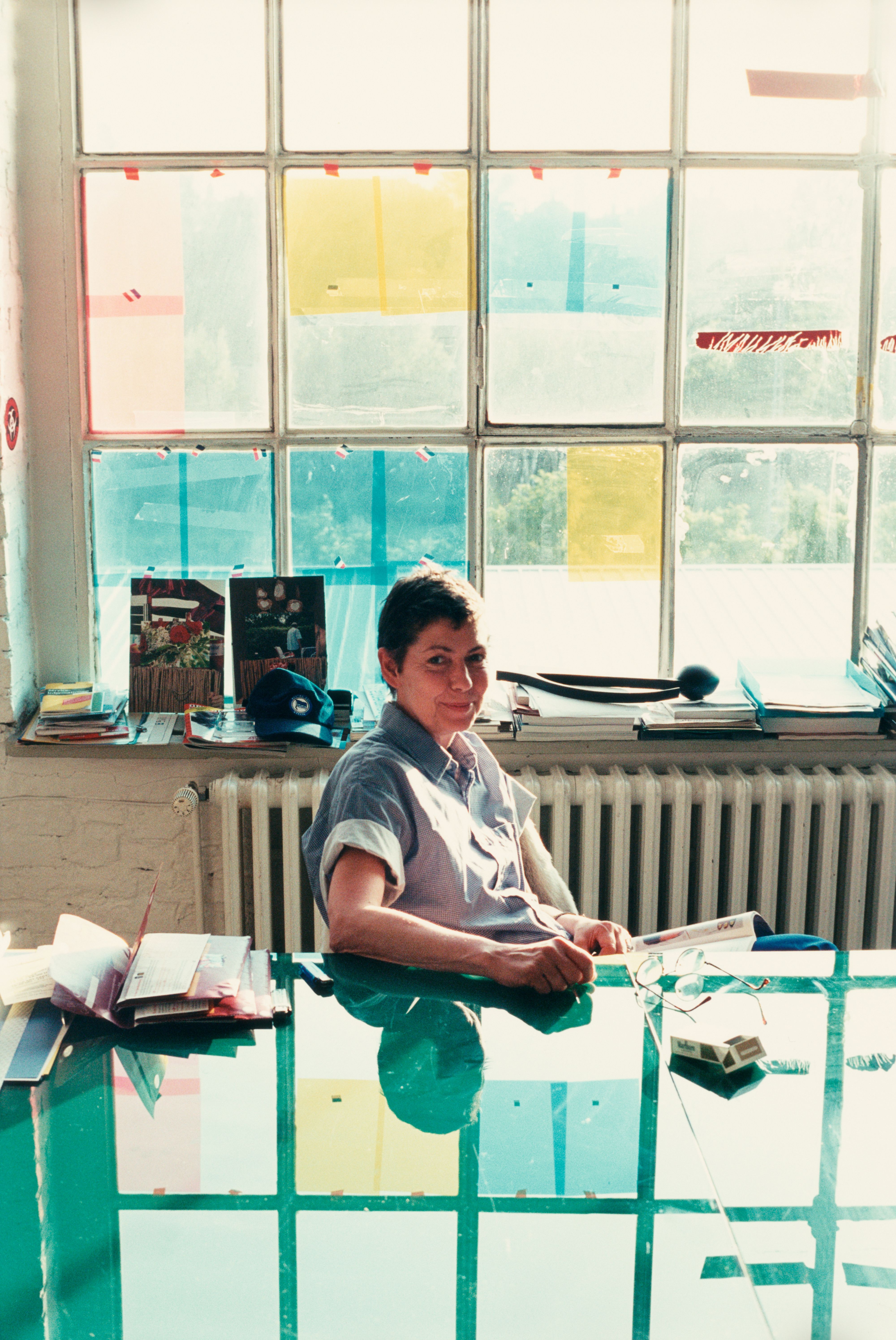
Isa Genzken in her studio in 2002. Portrait by Wolfgang Tillmans. Courtesy Galerie Buchholz.
“I have always said that with any sculpture you have to be able to say, although this is not a readymade, it could be one. That’s what a sculpture has to look like. It must have a certain relation to reality.” — Isa Genzken
In 1968, a year before Mies van der Rohe died, his design for West Berlin’s Neue Nationalgalerie opened. The Berlin Senate commissioned the architect to build the modern art museum in 1962, a year after the Wall went up; van der Rohe’s design stood just a few hundred meters from the barrier, close to other early 60s (re)constructions including the Philharmonie. van der Rohe had been the Bauhaus’s last director, ousted by the Nazis for his work not being adequately “German,” and by 1937 he’d emigrated to the United States. The Neue Nationalgalerie was a triumph for one half of a post-Nazi German state formation, the half that was, to some extent, controlled by America.
In 2000, German artist Isa Genzken said Fuck the Bauhaus with her series of sculptures. In spite of this — or perhaps because of it — she has long wanted to show in van der Rohe’s design according to Klaus Biesenbach and Lisa Botti, curators of the Genzken retrospective 75/75, which is on view at the Nationalgalerie until the end of November. Born in Schleswig-Holstein some months before the two Germanies officially formed, Genzken has shown in three documentas (the recurring art festival was founded 1955 in part as an antidote to Degenerate Art policies), and five Biennales (resumed in 48). Her work tracks turns through and against Modernisms (well, many –isms), and, collated in the David Chipperfield-refurbished Neue National, the past 75 years of European liberalism and capitalist expansion.

Isa Genzken, Nofretete – Das Original, 2012. Nefertiti plaster bust with sunglasses on wooden base, wooden plinth and colour photograph in aluminium frame. Courtesy Galerie Buchholz © VG Bild-Kunst, Bonn 2023. Photo: Sascha Fuis.
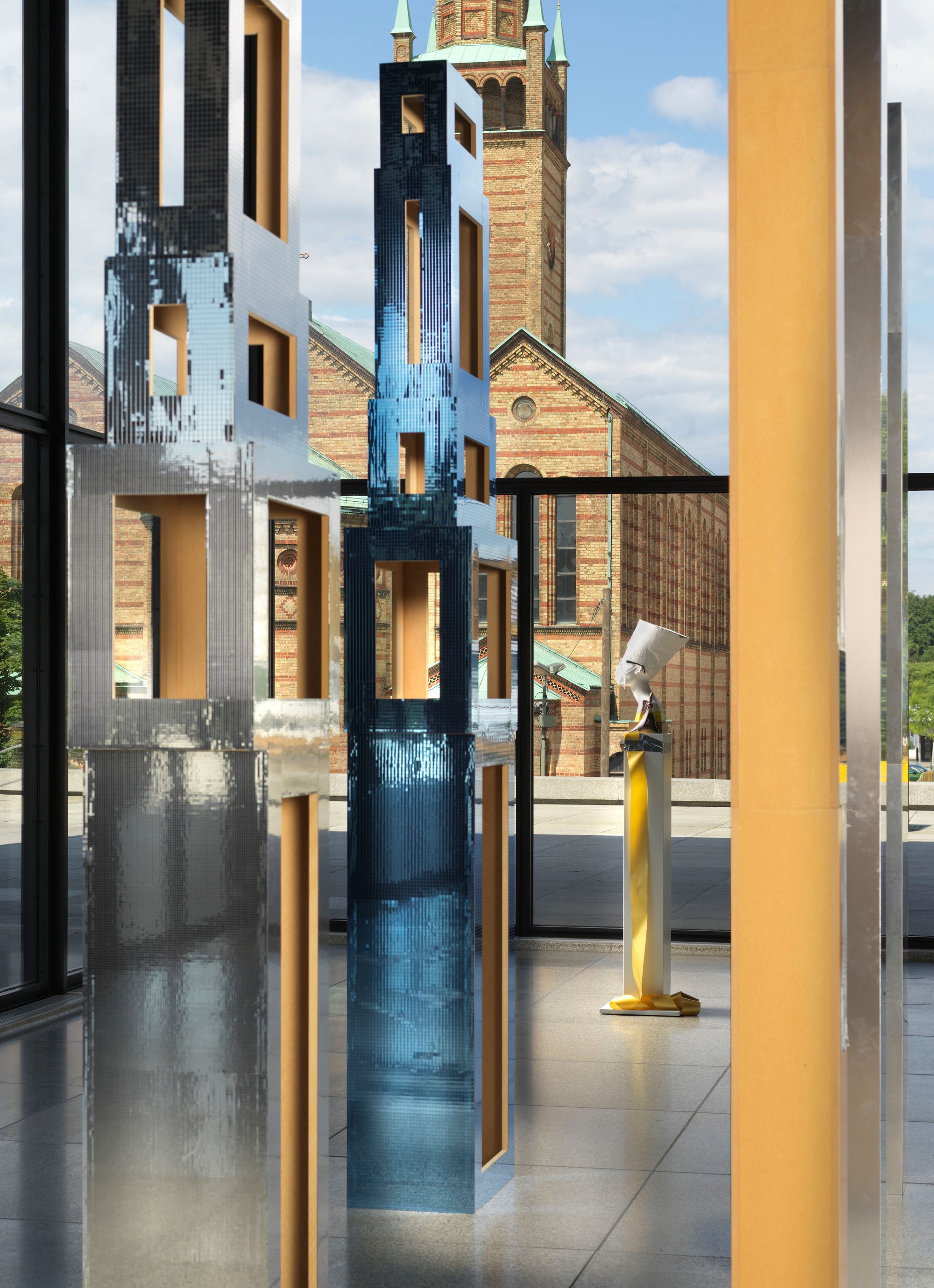
Isa Genzken, Ausstellungsansicht, at 75/75. Photo courtesy Galerie Buchholz © VG Bild-Kunst, Bonn 2023.
Working with advice from Genzken’s friends, including art dealer Daniel Buchholz, art collector Erika Hoffmann, and artist Wolfgang Tillmans, the curators selected 75 works from approximately 2,000 and organized them chronologically within the glass-wrapped pavilion’s grid. From a distance, you can basically see all 75 works simultaneously. Inside the exhibition, that’s kind of true too, though maybe less so, given they sometimes obstruct each other. Or frame one another: Genzken made a lot of windows. Beginning in 1990 with her Fenster series, she created casts of concrete and steel window frames, the mold’s styrofoam still sticking to certain spots; some resting on plinths; some with hinges, doubled up; others, taller, on the floor. For some Fenster sculptures, Genzken used colored resin either with or without concrete. What distinguishes the Fenster from a normal window, mainly, is that you can see in the round. They’re at once optical and object, the brutalist rejection of the milled, painted wood arcs of her 1970 sculptures Ellipsoids and Hyperbolos, which first read as Minimalist exercises. Despite their aesthetic differences, the Fenster pieces are these earlier works’ logical outcome: visual tools insistent on their referentiality — she’s said that she wanted the 70s works to possess “content” and evoke references to everyday objects — and their craft, made-ness.
Made simultaneously with the windows, X (1992) comprises three yellow epoxy and resin crosses on steel armatures, two meters high, with rectangles at top and bottom. Though at first appearing self-sufficiently formalist, the sculpture directly references the SOM-designed John Hancock Center in Chicago (1969). She’d use the same yellow epoxy and resin, plus teal up top, as hinged windows for Venedig (Venice, 1993). No geometry comes from nowhere.
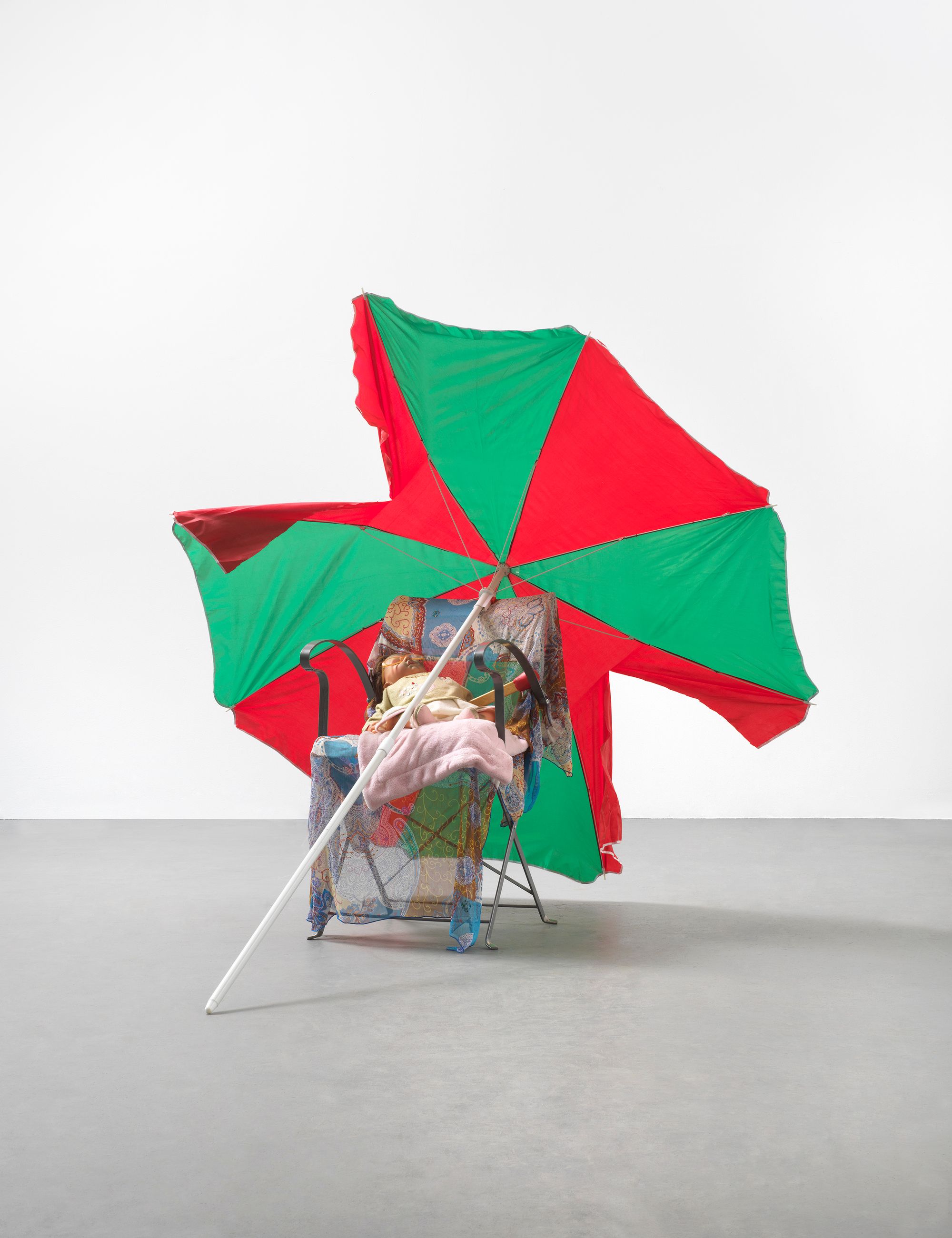
Isa Genzken, Untitled, 2006. Folding chair, doll, blanket, fabric, glasses, plastic, lacquer, spray paint, sunshade. Courtesy Galerie Buchholz.
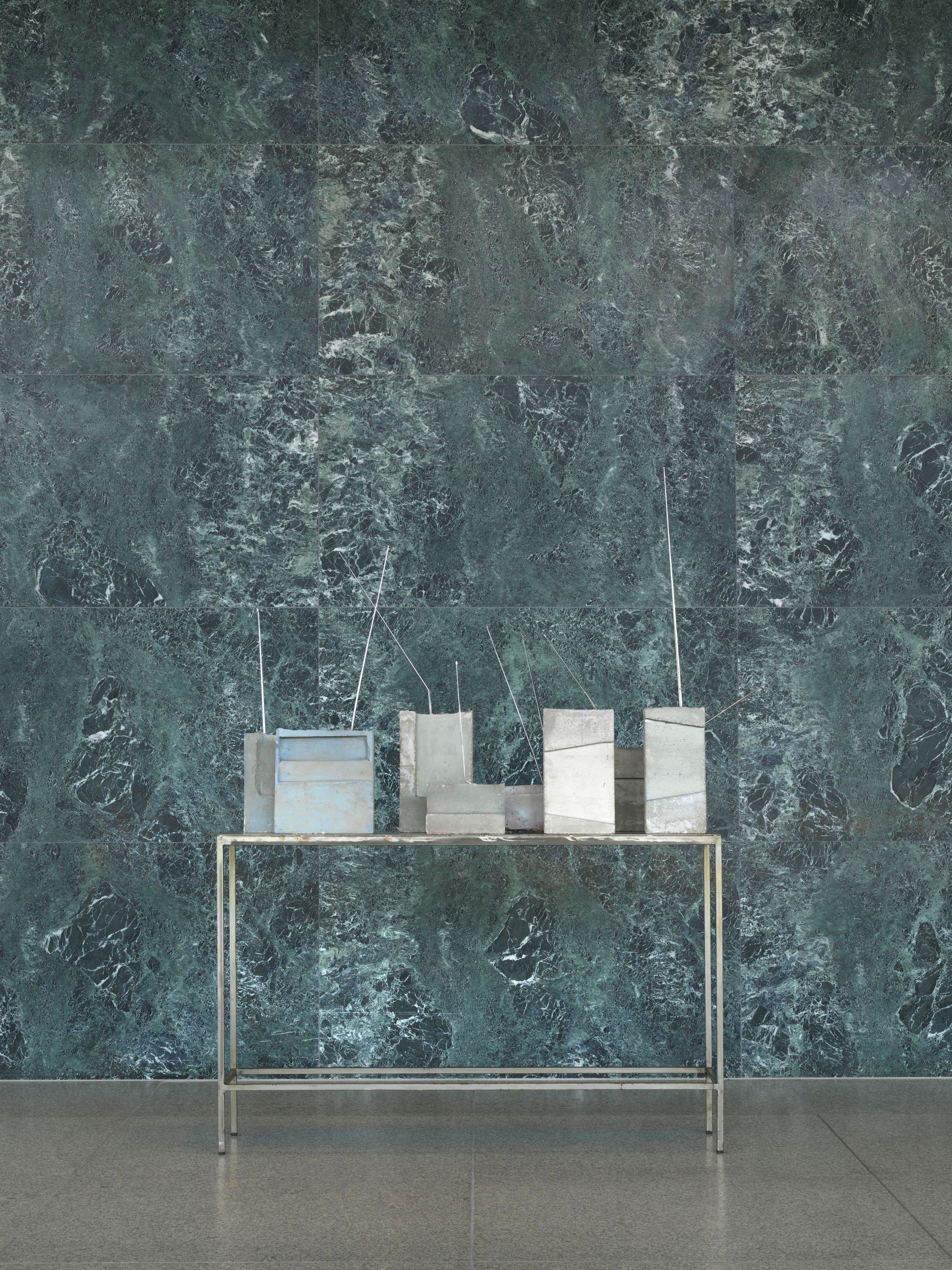
Isa Genzken, Ausstellungsansicht, at 75/75. Photo courtesy Galerie Buchholz © VG Bild-Kunst, Bonn 2023.
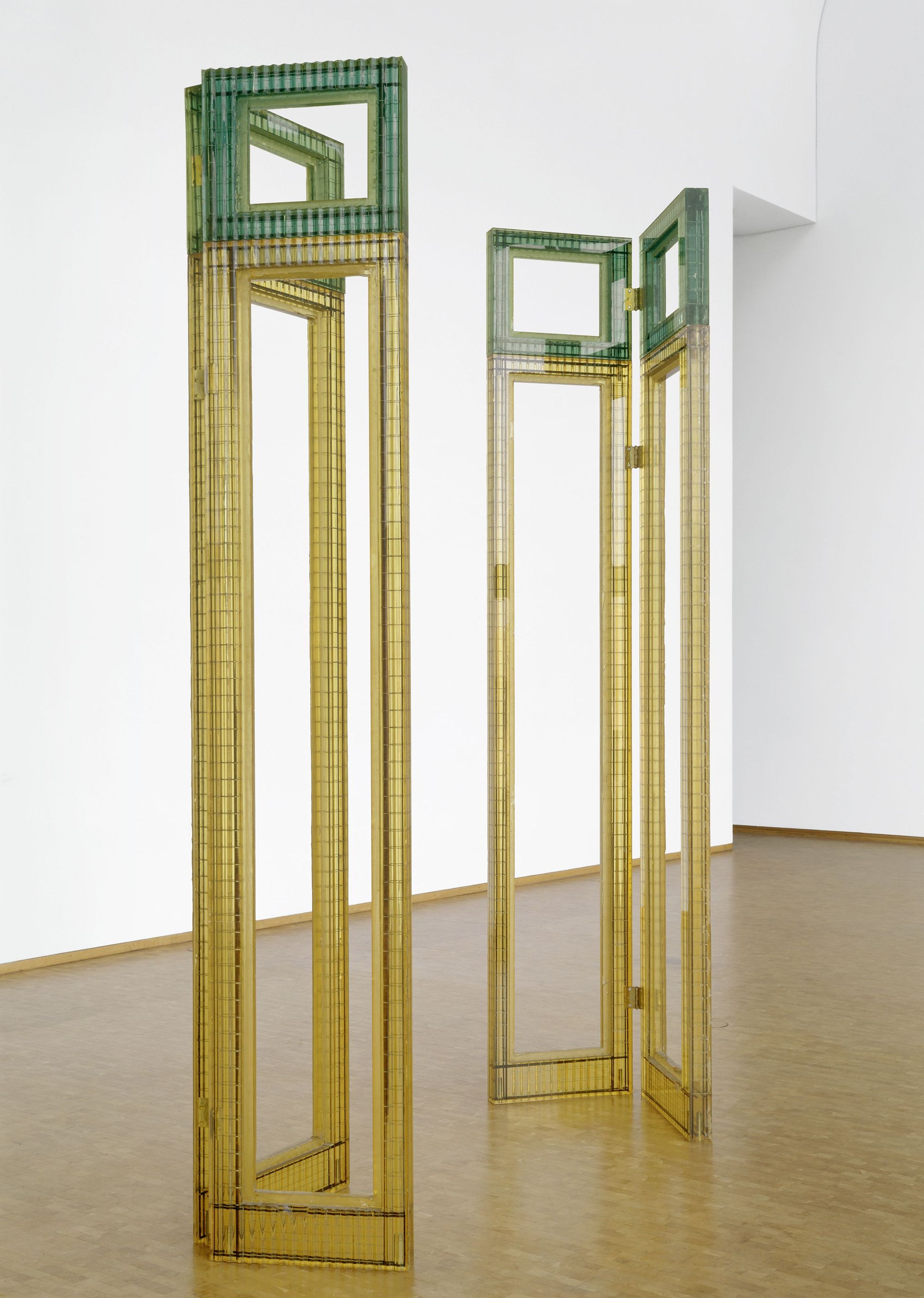
Isa Genzken, Venedig. Epoxy resin and steel. Photo courtesy Galerie Buchholz. © Rheinisches Bildarchiv Köln.
The grid and resin recurs on her Lampe (1994), would-be domestic objects — products, not out of spirit with her radio-like sculptures from the 80s — with resin peels and flesh-like ripples. However, in the context of the Mies Neue Nationalgalerie space, I want to return to Fuck the Bauhaus, specifically #2 (2000): a plywood plinth, wrapped meticulously with off-angle colored tape, topped with a pizza box and a flower shipping box decorated with, among other things, images of a rose, fake flowers, toy cars, little plastic trees, and pebbles. A curved orange grid, splattered with paint, sits atop the box, small chains dangling from it. These aren’t cast-offs: the pizza box is clean, greaseless. The flower box, which reads “Special Day New York,” is unwetted. These are proposals: they were first shown in Manhattan in a show subtitled New Work, New York.
One way to read Genzken’s practice is to see it as a reaction to Minimalism’s icy denial of content and context by way of Dadaism. For Der Junge Gewichtheber (The Boy Weightlifter, 2004), an egg-shaped chair rests sideways across a white-painted plinth that’s decorated with a sheet of mirrored squares. The left arm of an infant doll, eyes closed, drapes over the chair’s reflective stand. Genzken signed the base of the toppled chair. Fountain (1917) would be an obvious reference. Duchamp’s art is not just, Oh, I took this from one environment, now it’s in another, rarefied one and look, it’s oriented wrong! It’s: I went shopping — and since I’m an artist, my choice matters. That boy-artist did some heavy lifting!
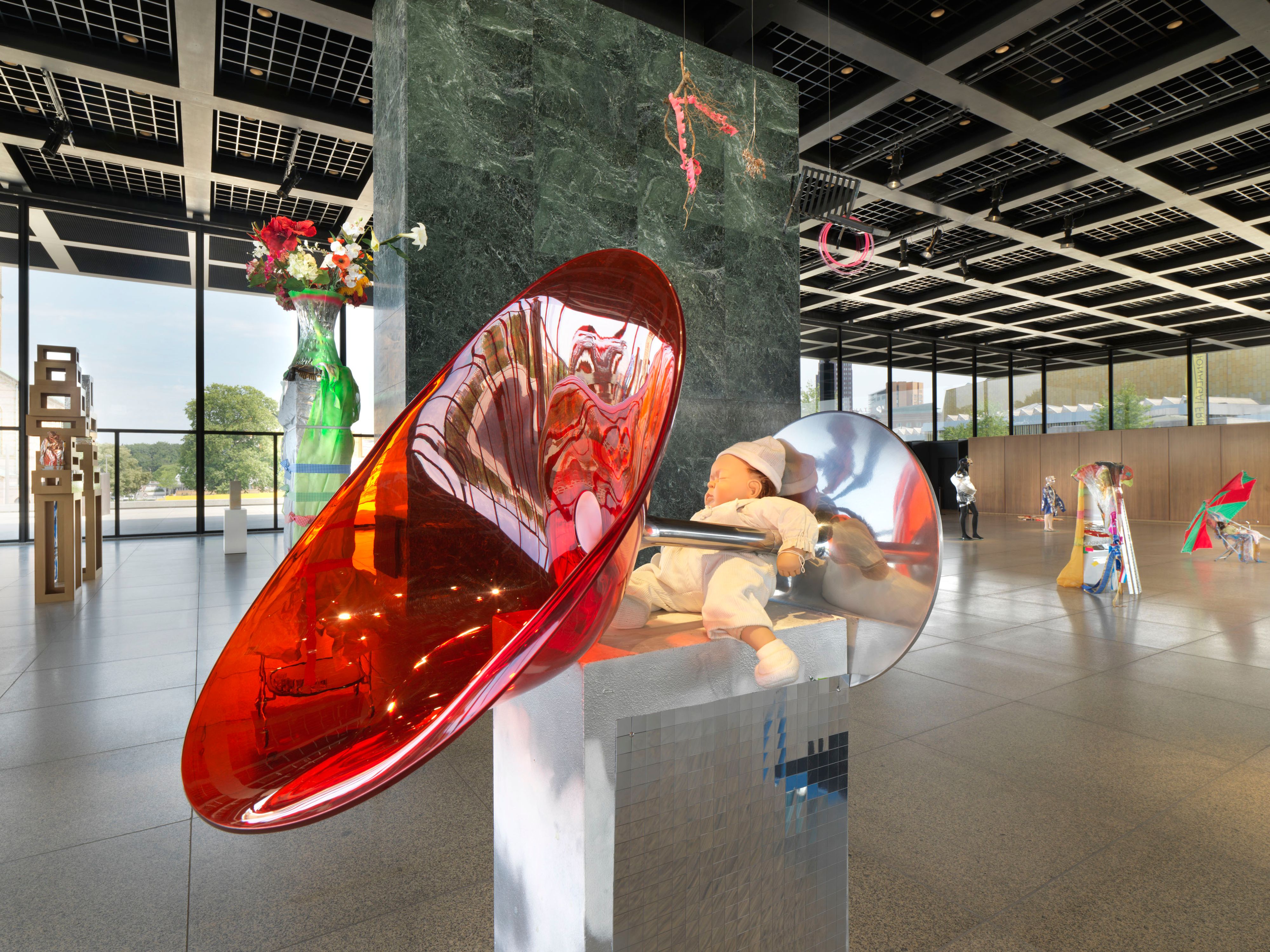
Isa Genzken, Ausstellungsansicht, at 75/75. Photo courtesy Galerie Buchholz © VG Bild-Kunst, Bonn 2023.
Genzken doesn’t pick random chairs: Kartell sells those I can identify. Designed by either Philippe Starck or Maarten van Severen, they retail from $500 to $2,000. On the materials checklist, they’re indexed as “plastics.” To harp on the Bauhaus, I’m reminded of how a radical project has reached its end in coffee table books set beside bouclé sofas in order to advertise “taste.” Refinement. People purchase objects to produce and project a sense of self. Genzken’s clashy reverence for and “misuse” of these objects restores it to an art, an art of the absurd.
Although the pizza box is pristine and the Ghost chairs are wrapped in plastic less like garbage but more like precious cargo to be moved, some things do get worked over: namely, people. While the baby boy weightlifter escapes defacement, the doll bent back over a massive matchstick in an untitled 2006 sculpture was not so lucky: its face is burnt; its pink blanket is dirty; the green and red beach umbrella meant to be protecting it is in tatters. Art historian David Joselit has pointed out that Genzken’s sculptures are not last century’s assemblages but distinct “centrifugal tornadoes of divergent associations.” Her series Empire/Vampire, Who Kills Death (begun 2003) demonstrates this spectacularly for me: toy soldiers mounting consumer goods — often joyful — that dwarf them in scale; they fall into wine glasses; they are muddled in masses of junk. Yet they never feel stuck on, put together. A painterly logic — and literal splattered paint — organizes the would-be discrete elements of these sculptures into twisted history tableaus.
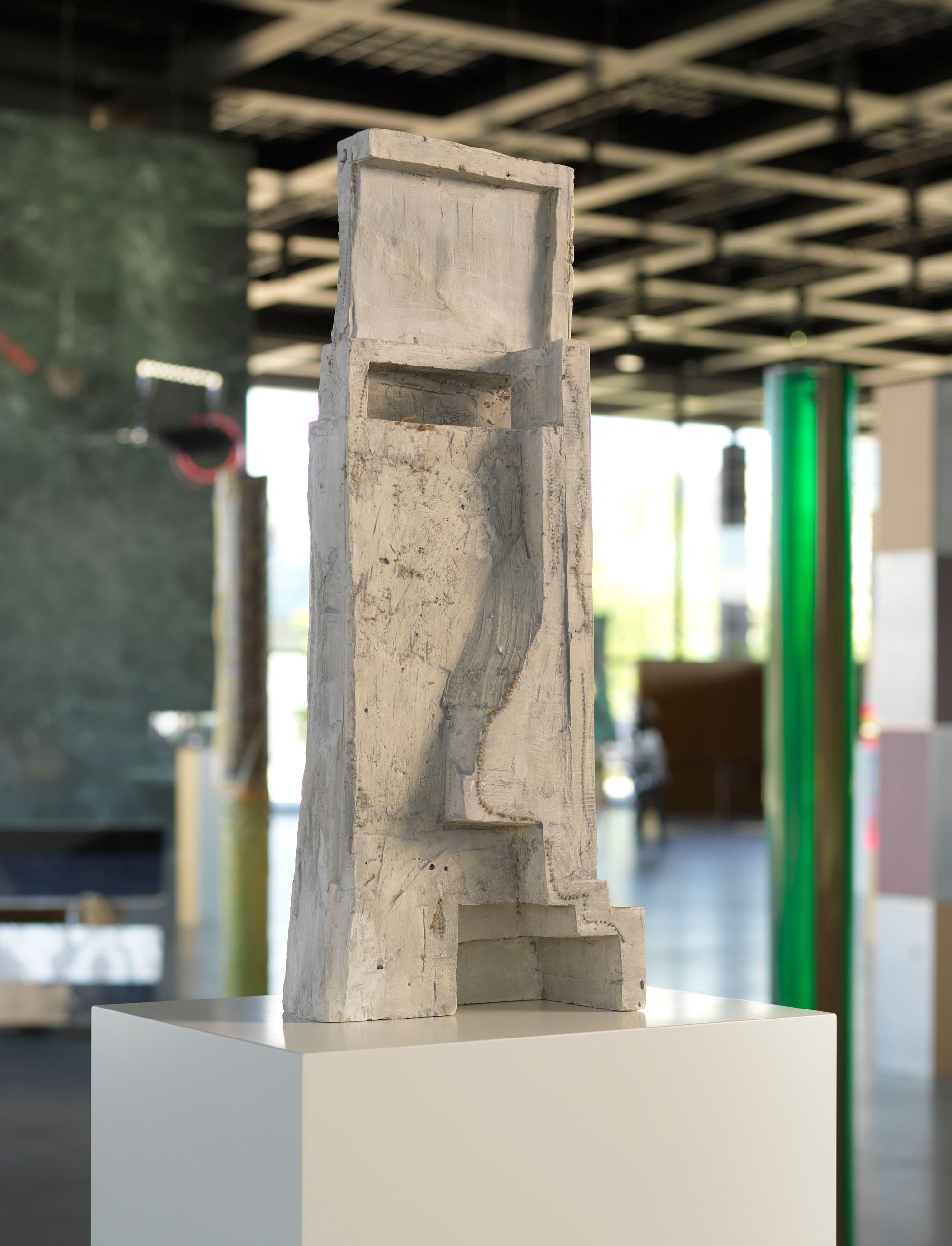
Isa Genzken, Ausstellungsansicht, at 75/75. Photo courtesy Galerie Buchholz © VG Bild-Kunst, Bonn 2023.
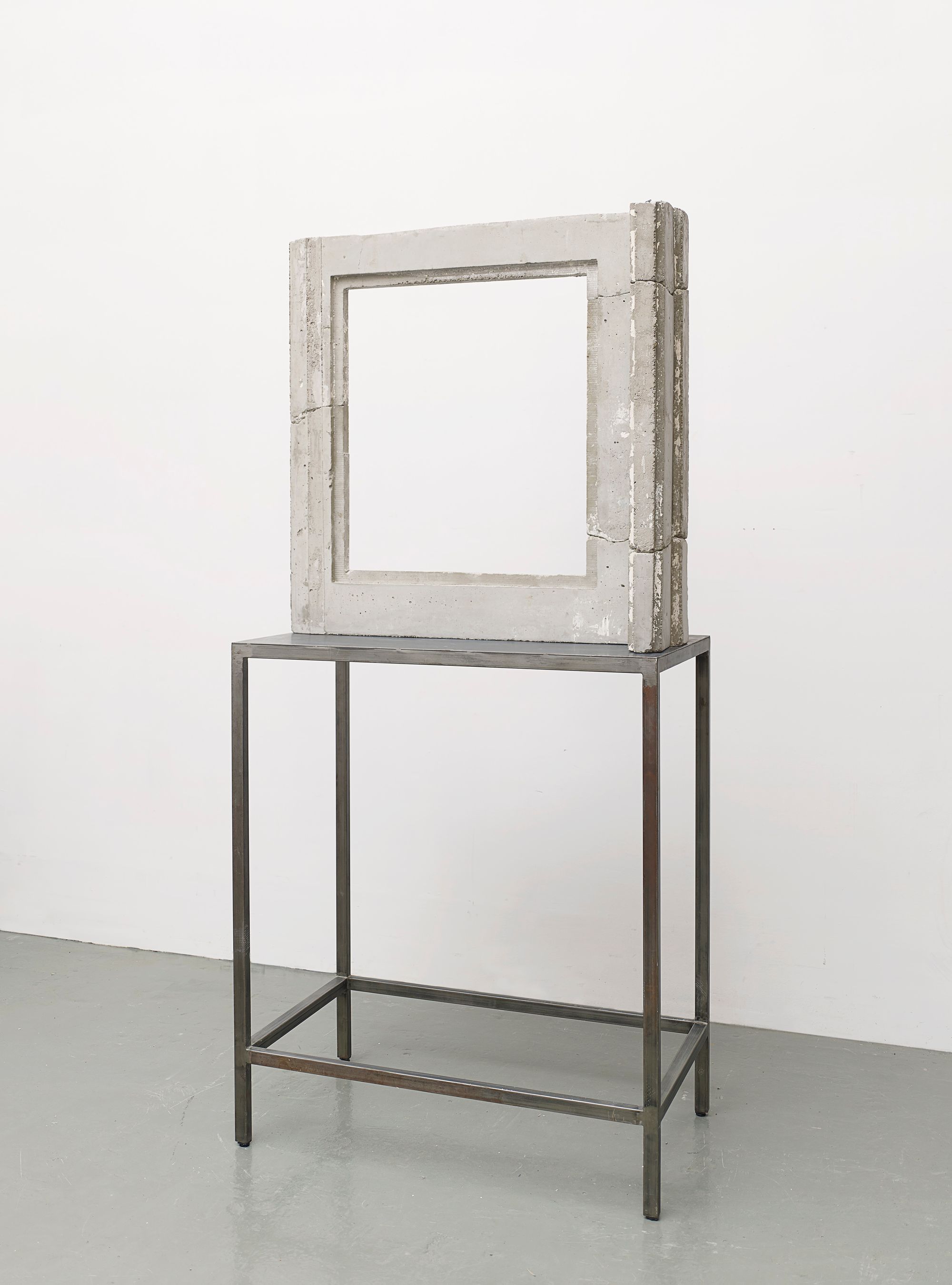
Isa Gensken, Fenster, 1990. Concrete, steel. Photo courtesy Galerie Buchholz © VG Bild-Kunst, Bonn 2023.
Empire marked a turn to more literal narrativity for Genzken: the titles referenced the Empire State and Chrysler buildings (the artist sees the latter as a kind of “vampire”) as well as the state they stand in for: “‘Empire’ makes you think of the US, it feels like looking at some scene of catastrophe,” exhibition materials quote Genzken saying. The soldiers reappear in an untitled sculpture from 2012, where a polychrome toy marches, as if lost, in what appears like the distance, an incredible invocation of pictorial space in a sculptural agglomeration. Another soldier, gallery white, comes out the nose of a rubber monster mask that’s been draped with a long blonde wig. Two non-matching transparent chairs rest with seats against each other, registering with uncanny sexuality. What happened to our junge Gewictheber? With these out-of-scale figures of differing, ambiguous genders, the furniture becomes less supporting objects for people than stand-ins for them — off-the-shelf identities, products of conflict and desire.
In the early 2010s, Genzken began playing with mannequins, those de-sexed adult dolls. A funny choice: mannequins are shoppers’ idealized human forms, as Classical sculptures were for the Renaissance artists, but rather than being consumer goods in-themselves, the plastic figures are platforms to sell other things. They participate in the production of gender as a capitalist and consumerist idiom expressed through “style,” through purchase-power aspirationalism. Genzken’s skin-colored mannequins wear kooky non-outfits of double-breasted jackets, tacky curtains, spindly head massagers, hockey masks, foam strips, and crinkled jeans, looking like stoned Neukölln vintage victims whose accumulation advertises the coming real estate shifts riding on artists’ backs. Genzken’s precision allows her to incorporate myriad forms — found objects, painting, design, photography, architecture — into “sculpture,” that loaded tradition. Fashion is another spatial aesthetic; rather than individualist expression, style again proves self-objectification, meaning-seaking in the chaos of commercial surplus, trickle-down pseudo-originality.
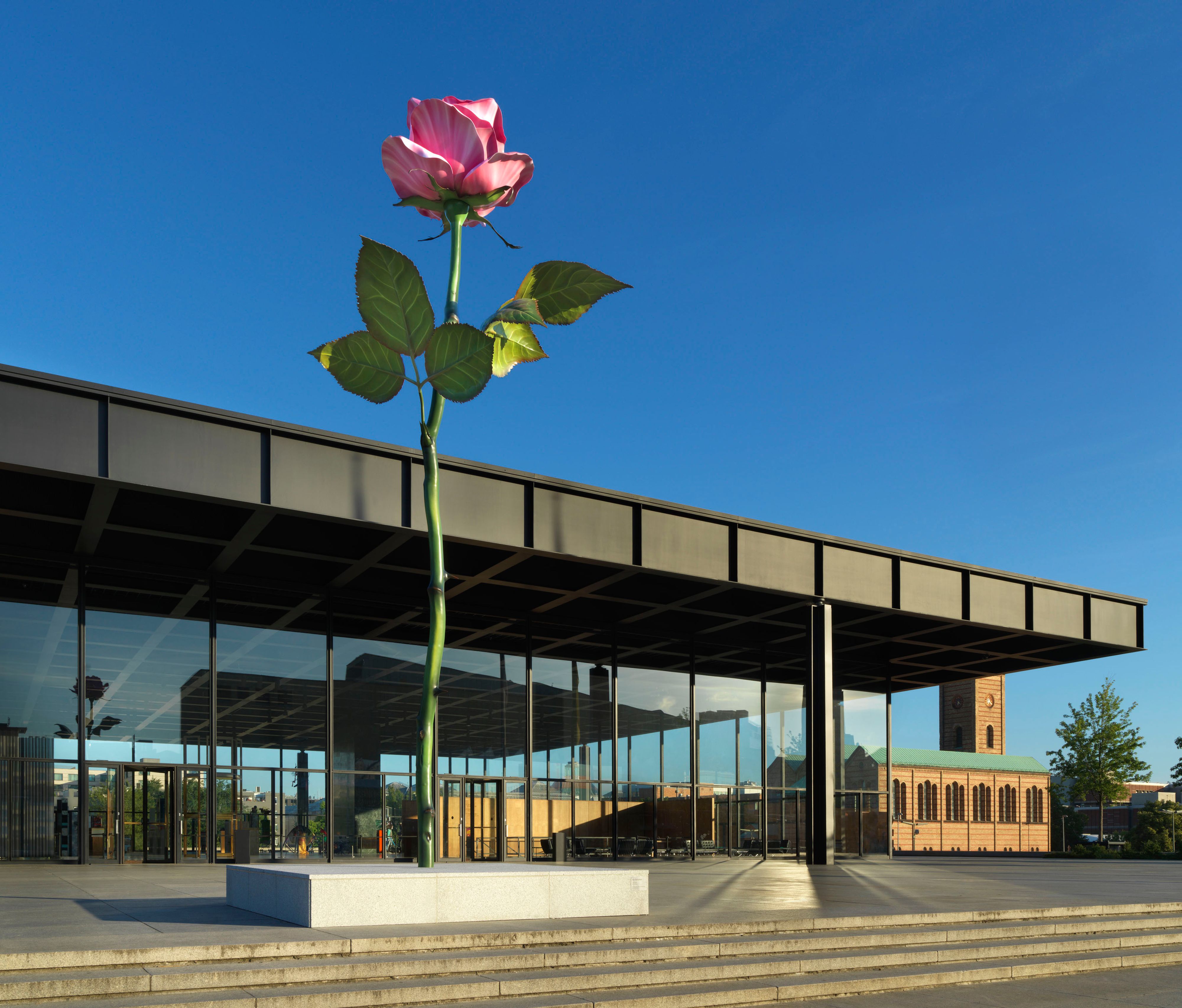
Isa Genzken, Ausstellungsansicht, at 75/75. PINK ROSE, 2016/2023; cast aluminum, paint, stainless steel. Photo courtesy Galerie Buchholz © VG Bild-Kunst, Bonn 2023.
The Argentinian novelist César Aira has written that contemporary art is a genre unto itself — for him finding its roots in Duchamp — which “ludicrously renounces History and spreads itself out as a permanent present.” In that sense, “Contemporary Art could be the realization of the teleology of modernism. It no longer pretends to herald the future, the future becoming of time, but is instead a smooth and flat realization of the present.” Looking at Genzken’s trajectory, one sees how of her time she has consistently been, but the work exceeds those moments, that “permanent present,” somehow. In her totemic cardboard stelae, which return to the column series she had initiated in the mid-90s, she opens the forms, expanding them into a more dynamic arrangement of variously proportioned hollow boxes — frames upon frames. Grouped together, their reference to urban centers, specifically New York, becomes clearer. But, in thinking of quote-unquote history with a big or little H, I am drawn to the presence of news magazines and papers. I don’t remember exactly what they featured. Some or all were in German. They mark time, in the On Kawara sense, maybe, though who knows how long they were lying in the studio. News media manufactures the contemporary by anticipating and insisting upon its historical import in advance of itself. Most people toss the paper when they’re done; just look at an untitled work from 2018: the CDs and mirror film and magazines and plexi that once found itself attached to architectonic, insistently vertical sculptures, have collapsed into a mess on the floor.
History is the everyday. Her true monument says as much: an aluminum and steel rose rising over 8 meters outside. Red roses became both amorous symbols and socialist signs in the Victorian era, though this one is pink. Does that make it more cliché or less? Still, how lovely to receive one. Indeed, what could be more special, or more banal? That is, sentimental. Looming in the plaza, it makes the museum, the city, small. I can’t think of a better fuck you to the Bauhaus, or a grander fuck you to grand gestures. What a cut flower celebrates best is impermanence. Pink Rose (2016/2023) comes down with the show, too.